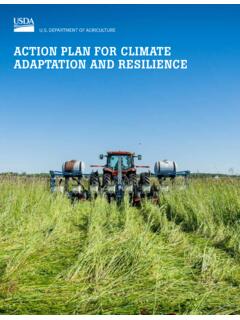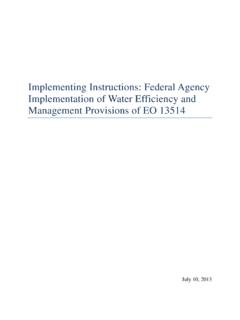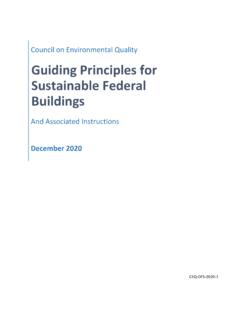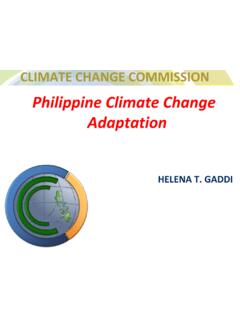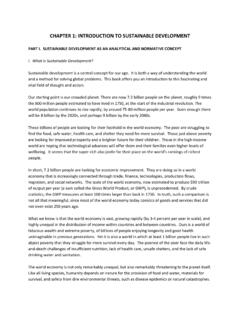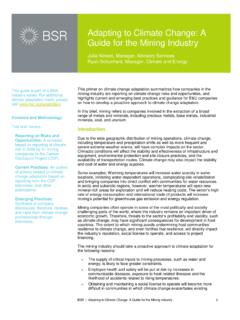Transcription of Climate Action Plan
1 Climate Action Plan Revitalizing Efforts to Bolster Adaptation & Increase Resilience August 2021 Office of the Secretary of Transportation Office of the Deputy Assistant Secretary for Climate Policy 1200 New Jersey Ave., SE Washington, DC 20590 2021 Climate Action Plan i DOT Policy Statement The world is facing an existential Climate crisis. Climate change presents a significant and growing risk to the safety, effectiveness, equity and sustainability of our transportation infrastructure and the communities it serves. We have a once-in-a-generation opportunity to address this risk. The United States Department of Transportation (DOT or Department) is going to lead the way. Over the last decade, DOT has integrated Climate change impacts, adaptation, and resilience into domestic and international planning, operations, policies, and programs.
2 However, more must be done. The Department has the opportunity and obligation to accelerate reductions in greenhouse gas emissions from the transportation sector and make our transportation infrastructure more Climate change resilient now and in the future. To do this, we will ensure that Federally supported transportation infrastructure, and DOT programs, policies, and operations, both consider Climate change impacts and incorporate adaptation and resilience solutions whenever possible, by following these guiding principles: Use Best-available Science. Adaptation and resilience strategies will be grounded in the best-available scientific understanding of Climate change risks, impacts, and vulnerabilities. Our adaptive actions will not be delayed all plans and actions will be continuously reevaluated as our understanding of Climate impacts evolves. Prioritize the Most Vulnerable. Adaptation and resilience plans will prioritize helping people, communities, and infrastructure that are most vulnerable to Climate impacts this includes underrepresented groups, low-income communities, communities of color, limited English proficient communities, and individuals with disabilities.
3 These plans will be designed and implemented through a transparent process with meaningful involvement in decision making from all parts of society. Issues of inequality and environmental justice associated with Climate change impacts and adaptation will be addressed. Preserve Ecosystems. Protecting biodiversity and ecosystem services through adaptation strategies will increase resilience of human and natural systems to Climate change and other risks, providing benefits to society and the environment ( in a coastal setting, wetlands serve as buffers to transportation assets and can minimize the impacts of storm surge). Build Community Relationships. Adaptation and resilience require coordination across multiple sectors, geographical scales, and units of government. Our actions will build on existing efforts, knowledge, and meaningful engagement of communities that are impacted. Because impacts, vulnerabilities, priorities and needs vary by region and locale, adaptation will be most effective when driven by local and regional risks and needs.
4 Engage Globally. The transformation of the global transport sector offers some of the most significant opportunities for deep greenhouse gas emissions cuts, healthier cities, and a once-in-a-generation opportunity to build resilient infrastructure. DOT is committed to working with other nations, multilateral organizations, industry, and non-governmental organizations to lead a global transformation that addresses Climate change mitigation, adaptation, and resilience. We cannot do this alone. State, regional, local, territorial, and Tribal transportation agencies are encouraged to build resilience and adaptation into their planning and decision-making processes. Private sector innovation and investment in Climate change resiliency and adaptation is needed. By working together, we can ensure that our transportation systems can adapt to future changes, minimize negative impacts, take advantage of innovative opportunities, and better serve people and communities, especially those traditionally vulnerable and underserved.
5 Secretary Pete Buttigieg2021 Climate Action Plan ii Table of Contents DOT Policy Statement .. ii I. Introduction .. 1 II. Leadership .. 1 III. Climate change Impacts on Transportation .. 2 IV. Priority Adaptation Actions .. 4 Priority Action : Incorporate Resilience into DOT Grant and Loan Programs .. 4 Priority Action : Enhance Resilience Throughout the Project Planning and Development Process .. 5 Priority Action : Ensure Resiliency of DOT Facilities and Operational Assets .. 7 Priority Action : Ensure Climate -ready Services and Supplies .. 9 Priority Action : Improve Climate Education and Research on Resilience .. 10 V. Vulnerabilities .. 12 Vulnerability: Projects Do Not Incorporate Resilience .. 12 Vulnerability: Location of Real Property and Operational Assets .. 13 Vulnerability: Disruption of Services and Supplies for Mission Critical Activities .. 13 Vulnerability: Lack of Sufficient Climate change Educational Resources at the Department.
6 14 Vulnerability: Insufficient Skilled Staff Trained with Knowledge of Resilience .. 15 VI. Agency Efforts to Enhance Workforce Climate Literacy .. 15 VII. Agency Actions to Enhance Climate Resilience for DOT Sites .. 16 Governance .. 16 Asset Management .. 17 Design and Construction .. 19 VIII. Agency Actions to Ensure a Climate -Ready Supply of Products and Services .. 19 Services and Supplies Most Vulnerable to Climate 20 IX. Climate change Impacts and Equity .. 21 X. Agency Actions to Incorporate Climate change Resilience into Strategic Plans .. 22 2021 Climate Action Plan 1 I. Introduction Pursuant to Section 211 of Executive Order ( .) 14008, Tackling the Climate Crisis at Home and Abroad and Council on environmental Quality s (CEQ) Implementing Instructions,1 the Department of Transportation (DOT or Department) has developed and submitted this Climate Action Plan (Plan). This Plan builds from the previous Climate Action Plans prepared in 2012 and 2014, respectfully.
7 The 2012 Action Plan focused on the Climate change s impacts to DOT s critical mission activities safety, state of good repair and federally owned building s environmental sustainability. The 2014 Climate Adaptation Plan provided updates on DOT s accomplishments to date and Fiscal Year (FY) 2013 and FY2014 commitments. This Plan follows the CEQ Instructions for Preparing Draft Climate Action Plans under . 14008 and focuses on Climate adaptation and resilience2 across agency programs and the management of Federal procurement, real property, public lands and waters, and financial programs. While the Department is engaged in a wide variety of activities related to reducing transportation sector greenhouse gas emissions, this Plan focuses on actions to bolster adaptation and increase resilience. II. Leadership The Office of the Secretary (OST) is responsible for the development, management, and execution of this Plan, through the leadership of the Deputy Assistant Secretary for Climate Policy and Chief Sustainability Officer (CSO), in coordination with the Department s modal Operating Administrations (OA), the Office of the General Counsel, and the Office of the Chief Financial Officer.
8 Additionally, the Office of Policy, within OST, coordinates Climate adaptation actions with support from DOT s Climate change Center. In 2021, President Biden appointed a Deputy Assistant Secretary for Climate Policy at DOT. The Deputy Assistant Secretary is responsible for the oversight and guidance of Departmental Climate change adaptation and mitigation actions with internal and external stakeholders. In partnership with the Chief Sustainability Officer and OAs, the Deputy Assistant Secretary for Climate Policy promotes Climate change preparedness and resiliency initiatives. The OAs below have committed to fulfilling specific adaptation actions to increase Climate change preparedness. In turn, they report progress on priority adaptation actions along with other regulatory and sustainability actions to the Deputy Secretary at regularly scheduled meetings. Federal Aviation Administration (FAA) Federal Highway Administration (FHWA) Federal Motor Carrier Safety Administration (FMCSA) Federal Railroad Administration (FRA) Federal Transit Administration (FTA) Maritime Administration (MARAD) National Highway Traffic Safety Administration (NHTSA) 1 Council on environmental Quality, Interim Instructions for Preparing Draft Climate Action Plans under Executive Order 14008, March 2021.
9 2 Resilience, as defined in the Global change Research Program s Fourth National Climate Assessment and CEQ Instructions for Preparing Draft Climate Action Plans under Executive Order 14008, means the ability to anticipate, prepare for, and adapt to changing conditions and withstand, respond to, and recover rapidly from disruptions. Adaptation means adjustment in natural or human systems in anticipation of or response to a changing environment in a way that effectively uses beneficial opportunities or reduces negative effects. As such, Departmental actions to reduce greenhouse gas emissions are not included. 2021 Climate Action Plan 2 Pipeline and Hazardous Materials Safety Administration (PHMSA) Great Lakes St. Lawrence Seaway Development Corporation (GLS) III. Climate change Impacts on Transportation DOT and its OAs oversee the safe operation of the United States ( ) transportation system including more than million miles of public roads, 617,000 bridges, 136,851 railroad route miles, million miles of pipelines, 25,000 miles of commercially navigable waterways, 3,321 public-use airports, 950 urban transit agencies, and more than 300 coastal, Great Lakes, and inland waterways The effects of Climate change are increasing over time.
10 The Global change Research Program s Fourth National Climate Assessment stated that thousands of studies have documented changes in surface, atmospheric, and oceanic temperatures; melting glaciers, diminishing snow cover; shrinking sea ice; rising sea levels; ocean acidification; and increasing atmospheric water vapor around the world. These changes are expected to increase exponentially as the annual average temperatures are anticipated to rise by about degrees Fahrenheit for the United States over the next few decades. It is extremely likely that the dominant cause of the observed warming since the mid-20th century is due to anthropogenic activities, especially from greenhouse gas (GHG) DOT recognizes that Climate variability and change pose threats to transportation systems (See Figure 1: Notable Potential Impacts). The range of impacts from these threats may include flooding and damage to highways and subway tunnels, limited waterway access, buckled runways, and weakened structures such as bridges.
